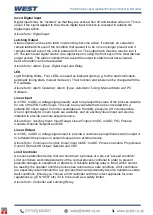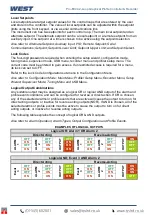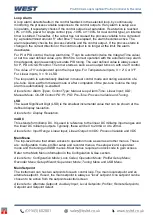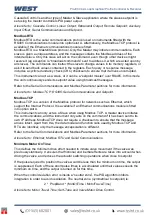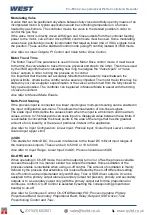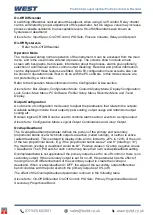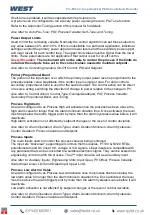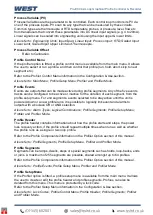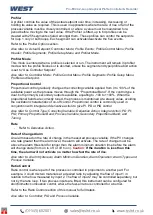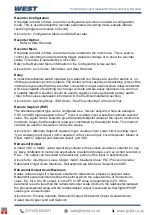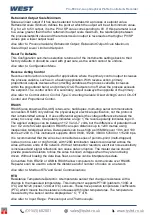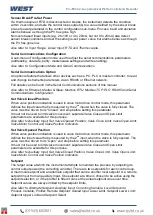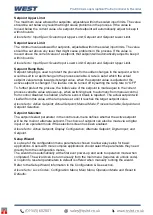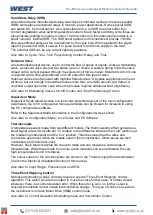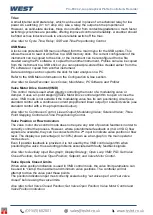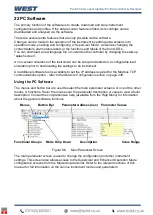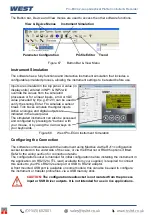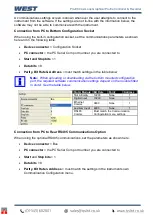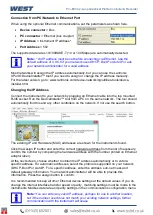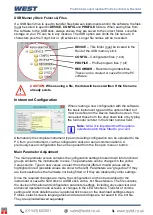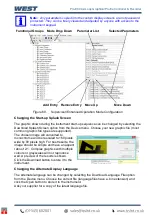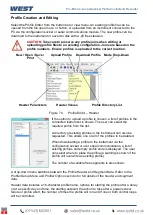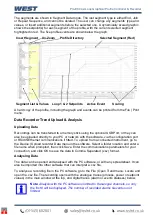
Pro-EC44 2-Loop Graphical Profile Controller & Recorder
Pro-EC44 Product Manual - 59540-2 September 2014
Page 228
Retransmit Output Scale Minimum
Scales a linear output if it has been selected to retransmit a process or setpoint value.
Retransmit scale minimum defines the point at which the output will be at its minimum value.
E.g. for a 0 to 5V output, it is the PV or SP value corresponding to 0V. If this parameter is set
to a value greater than that for retransmit output scale maximum, the relationship between
the process/setpoint value and the retransmission output is reversed so that higher PV/SP
values give a lower output level.
Also refer to: Process Variable; Retransmit Output; Retransmit Output Scale Maximum;
Scaled Input Lower Limit and Setpoint.
Reset To Defaults
This Configuration sub-menu selection returns all of the instruments settings back to their
factory defaults. It should be used with great care, as the action cannot be undone.
Also refer to: Configuration Menu.
Reverse Acting Control
Reverse control action is required for applications where the primary control output increases
the process variable, such as in a heating application. With reverse action, primary
proportional outputs decrease the correcting variable as the process variable increases
within the proportional band, and primary On-Off outputs turn off when the process exceeds
the setpoint. The control action of a secondary output is always the opposite of the primary.
Also refer to: Control Action; Control Type; Correcting Variable; Direct Acting Control; On-Off
Control and Proportional Control.
RS485
RS485 (also known as EIA-485) is two-wire, half-duplex, multi-drop serial communications
connection. RS485 only defines the physical layer electrical specification, not the protocol
that is transmitted across it. It uses differential signals (the voltage difference between the
wires) to convey data. One polarity indicates a logic 1, the reverse polarity indicates logic 0.
The applied voltages can be b12 V and -7 volts, but the difference of potential must
be > 0.2 volts for valid operation. RS485 can span distances up to 1200 metres using
inexpensive twisted pair wires. Data speeds can be as high as 35 Mbit/s over 10 m and 100
kbit/s at 1200 m. This instrument supports 4800, 9600, 19200, 38400, 57600 or 115200 bps.
It is recommended that the wires be connected as series of point-to-point (multi-dropped)
nodes (not in a star or ring format), with 120
Ω termination resistors connected across the
wires at the two ends of the network. Without termination resistors, electrical noise sensitivity
is increased and signal reflections can cause data corruption. The master device should
provide powered resistors to bias the wires to known voltages when they are not being
driven. Without biasing the data lines float, so noise can be interpreted as data.
Converters from RS232 or USB to RS485 allow computers to communicate over RS485.
Repeaters can be used to extend the distance and/or number of nodes on a network.
Also refer to: Modbus RTU and Serial Communications
RTD
Resistance Temperature Detector. A temperature sensor that changes resistance with a
change in the measured temperature. This instrument supports PT100 (platinum, 100Ω at
0°C) and NI120 (nickel, 120Ω at 0°C) sensors. These have positive temperature coefficients
(PTC) which means their resistance increases with higher temperatures. The temperature
measured by the sensor can be displayed as °C; °F or K.
Also refer to: Input Range; Process Input and Thermocouple.
Содержание Pro-EC44
Страница 1: ...Pro EC44 2 Loop Graphical Profile Controller Recorder Pro EC44 User Guide 59540 2 ...
Страница 2: ......
Страница 6: ......


